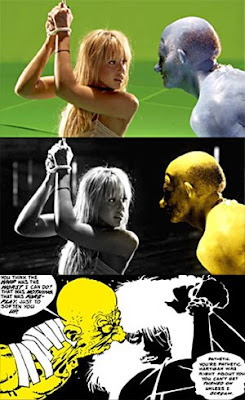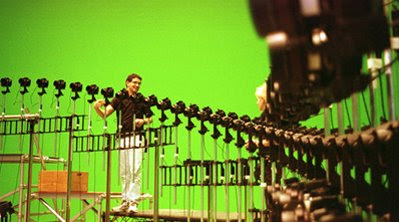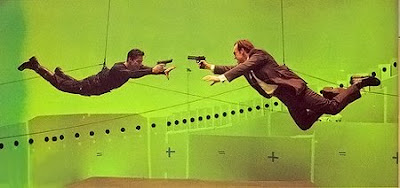Green screening offers huge potential for low-budget film makers as it allows for virtual worlds to be created around their actors at minimal cost. Set design, prop building, locations fees, lighting, and crew are just a few of the overhanging expenses that can be minimized, if not completely eradicated from the budget. However, that's not to say that monstrous, expensive films avoid green screen - quite the opposite, in fact.
So what kinds of things happen on multimillion dollar film sets?
To answer this question, I want to provide some insight into two of my favorite blockbuster movies, and how green screen was used to create the types of settings and shots that were needed to achieve the director's vision.
1) Sin City
Quite literally, the entire stock of raw footage for Sin City was shot using green screen. Every shot was set up and filmed with a much greater vision in mind. The true magic of Sin City, in addition to the storyline, was performed by the post-production editors. Hours and hours of painstaking 3D scene building, layering, and editing were required to achieve a stunning result.
 In the end, the visuals in the film took the graphic novel to new heights while managing to retain Miller's original look and feel. Let's have a look at some actual raw footage:
In the end, the visuals in the film took the graphic novel to new heights while managing to retain Miller's original look and feel. Let's have a look at some actual raw footage:
If you can't remember what the edited scene looked like, check it out here.
Sometimes you just have to see how basic the raw footage is before you can actually understand how good some of the video editors and CGI experts are that work on these types of films. If you want to see just how much green screening went on in the making of Sin City check out this nine minute clip of various unprocessed footage. It's definitely worth seeing.
2) The Matrix
Realizing the complex concept behind The Matrix still stands as one of the most ingenious film making efforts ever. The Matrix unveiled new visual styles that set a new high for CGI-based film makers around the world.
There's far too many scenes worthy enough to discuss in the movie, but some of the most mind-blowing have got to be the time-haltering, panoramic pans. To achieve this look, a huge chroma-key green set was designed, and then outfitted with both still and video cameras. How many cameras? I don't know... I lost count. OK, fine, there are precisely 120 DSLRs, and two motion picture cameras.
 Once the cameras were placed in accordance to the desired shot they were hidden behind another green wall to make things easier for the editors. The final footage is actually a time-lapse merge of still photos taken in sequential order by the array of cameras you see above. Here's a shot of the scene during a take:
Once the cameras were placed in accordance to the desired shot they were hidden behind another green wall to make things easier for the editors. The final footage is actually a time-lapse merge of still photos taken in sequential order by the array of cameras you see above. Here's a shot of the scene during a take:
 Everything in the set was made custom by the designers for The Matrix. Because the panoramic pans were used many times throughout the film, the set was designed to be modifiable so that it could be reshaped in accordance to the footage required. The style became loosely known as bullet-time photography, as the scenes required dynamic camera movement around slow-motion events that approached 12,000 frames per second.
Everything in the set was made custom by the designers for The Matrix. Because the panoramic pans were used many times throughout the film, the set was designed to be modifiable so that it could be reshaped in accordance to the footage required. The style became loosely known as bullet-time photography, as the scenes required dynamic camera movement around slow-motion events that approached 12,000 frames per second.
Here's a look at how the unprocessed camera footage appears when placed on a video timeline:
This technique requires a lot of time and precision, but in the end, it allows for a compelling and quite revolutionary end product.
So there's a glimpse into how green screen, and chroma-key green sets are used to produce a final product. Green screening is best used when your required work demands footage that is either out of budget, and/or out of this world. Used wisely and creatively, the potential for green screen usage is virtually unlimited - as long as we're able to keep pumping out sweet ideas.
2) The Matrix
Realizing the complex concept behind The Matrix still stands as one of the most ingenious film making efforts ever. The Matrix unveiled new visual styles that set a new high for CGI-based film makers around the world.
There's far too many scenes worthy enough to discuss in the movie, but some of the most mind-blowing have got to be the time-haltering, panoramic pans. To achieve this look, a huge chroma-key green set was designed, and then outfitted with both still and video cameras. How many cameras? I don't know... I lost count. OK, fine, there are precisely 120 DSLRs, and two motion picture cameras.
 Once the cameras were placed in accordance to the desired shot they were hidden behind another green wall to make things easier for the editors. The final footage is actually a time-lapse merge of still photos taken in sequential order by the array of cameras you see above. Here's a shot of the scene during a take:
Once the cameras were placed in accordance to the desired shot they were hidden behind another green wall to make things easier for the editors. The final footage is actually a time-lapse merge of still photos taken in sequential order by the array of cameras you see above. Here's a shot of the scene during a take: Everything in the set was made custom by the designers for The Matrix. Because the panoramic pans were used many times throughout the film, the set was designed to be modifiable so that it could be reshaped in accordance to the footage required. The style became loosely known as bullet-time photography, as the scenes required dynamic camera movement around slow-motion events that approached 12,000 frames per second.
Everything in the set was made custom by the designers for The Matrix. Because the panoramic pans were used many times throughout the film, the set was designed to be modifiable so that it could be reshaped in accordance to the footage required. The style became loosely known as bullet-time photography, as the scenes required dynamic camera movement around slow-motion events that approached 12,000 frames per second.Here's a look at how the unprocessed camera footage appears when placed on a video timeline:
This technique requires a lot of time and precision, but in the end, it allows for a compelling and quite revolutionary end product.
So there's a glimpse into how green screen, and chroma-key green sets are used to produce a final product. Green screening is best used when your required work demands footage that is either out of budget, and/or out of this world. Used wisely and creatively, the potential for green screen usage is virtually unlimited - as long as we're able to keep pumping out sweet ideas.
No comments:
Post a Comment